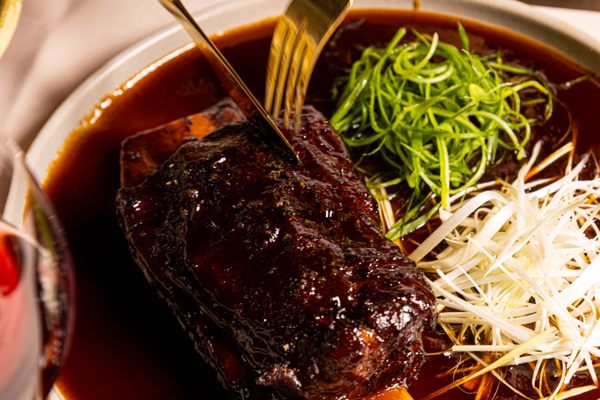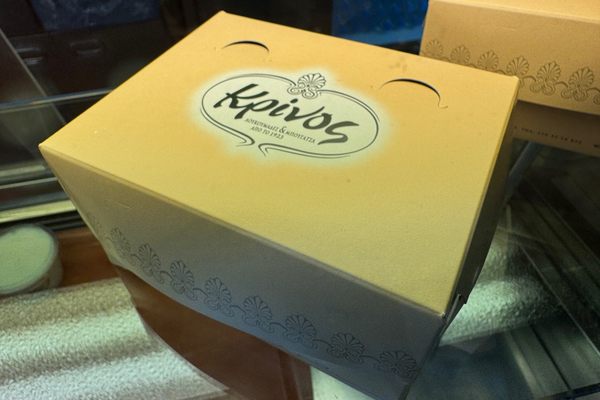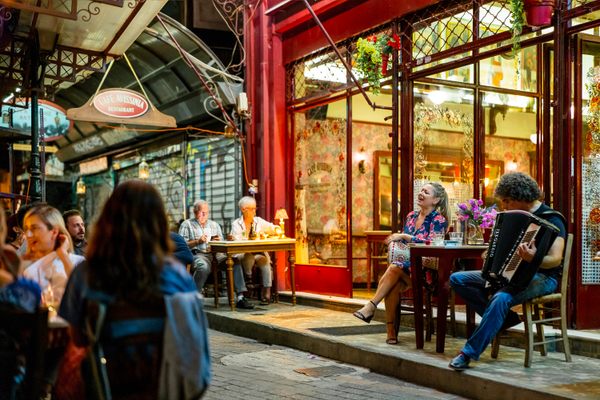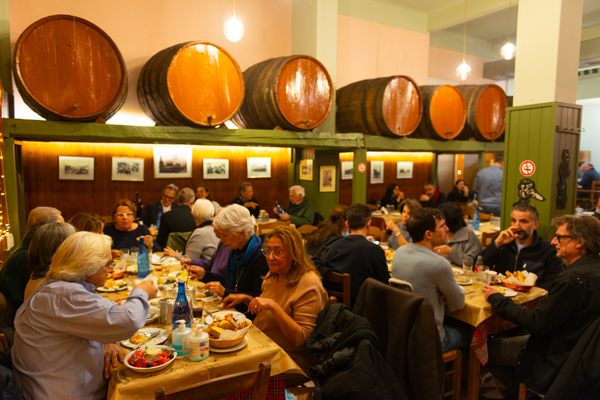Athens has been a dining destination since the 5th century B.C. More than a thousand years before Parisians coined the term “restaurant,” ancient Athenians boasted both public places to eat and a fledgling tourism industry. Archaeologists digging around in the Tholos, a rotund ruin in the heart of the Agora, have found animal bones and shattered cooking vessels—remnants of hearty meals taken by long-deceased public officials. Under Roman rule, thermopolia were casual eateries pouring wine and serving meals to the working class.
After centuries of military occupations and economic hardship, the Greek capital is once again a cultural and culinary epicenter. While an influx of cash inevitably leads to a boom in trendier restaurants, Athenians are fiercely protective of their generations-old tavernas and kafeneion.

Today, Athens and its restaurant scene are a patchwork of the new and the very, very old. Wander just around the corner from the tourist trap restaurants Plaka, and you’ll find 19th-century canteens and bakeries, plus bars where young Greeks pour wines from thousand-year-old grape varietals. Here’s where to dine extremely well in Athens.
To the Tavernas
While depictions of dining in ancient Greece tend to focus on symposiums—lavish, wine-soaked feasts thrown by educated upper-class men—everyday citizens got their booze at the local taverna, or kapeleia. A couple millennia later, tavernas are still central to social life in Athens. Many of the best examples have remained unchanged for decades—if not much more.

In 1986, Ketty Koufonikola opened the Cafe Avissinia near Monastiraki’s famous flea market and filled the space with antique bric-a-brac. Come for the regional Macedonian specialties such as yaprakia (a sour, pork-stuffed cabbage), stay for the live renditions of rebetika, which often devolve into boozy dance parties. A 15-minute stroll away, To Triantafyllo tis Nostimias has had a reputation since 1995 for serving the silkiest fava purée in town.
Tucked away in a stone, subterranean chamber behind two unmarked doors just off of Varvakios Market, Diporto has been in business since 1887, although the rumor is there may have been wine flowing in this space for far longer. There’s no menu, so just grab a seat below the enormous barrels and wait for owner Mitsos to send out plates of fried sardines, briney feta-topped salad, and slow-simmered chickpeas until you’ve had enough. Diporto is no longer the well-kept secret it once was, but prices and the vibe have remained stubbornly unchanged. When the line is too long, head around the corner to Tis Theatrou to Steki, where it’s still possible to have a midday feast for under €10.

Turkish Influences
Thanks to centuries of invasions, occupations, and migration between Turkey and Greece, the gastronomic lines between the two often get hazy. Fatsio, a local canteen, specializes in politiki kouzina (city cooking), or the food of the Greek diaspora in Turkey. Georgios Fatsios founded the restaurant in 1948 in Istanbul, then reopened it in Athens in 1969. Both the interior and the glass case laden with homey fare like braised artichokes, or eggplant topped with minced veal and béchamel, feel frozen in time.
Phyllo dough is another area where Turkish and Greek in culinary histories overlap. With roots in 11th-century Turkey (although some scholars have claimed a version of this very finely rolled “leaf,” or filo, is referenced in Homer’s Odyssey), it remains an essential part of cuisines in all corners of the former Ottoman Empire. In Athens, it forms the basis for countless savory pies.

If you’ve only had wan international renditions of spanakopita made with frozen filo, a warm slab of the tiropita (cheese pie) at Ariston will be a revelation. Bakers have been layering the rich kourou phyllo made with butter and yogurt since 1910. Less famous, but just as good, is Pandora, where the phyllo is rolled out before your eyes each morning. At roughly €3 per flaky, buttery slice, it’s a rare non-tourist trap near the Acropolis.
Coffee and Sweets
Like so many cities, Athens has no shortage of third-wave coffee houses pouring flat whites to a laptop-toting crowd. Walk straight past a string of these in Monastiraki and go instead to Kafeneio Oraia Ellas (“Beautiful Café Greece”), a former gathering place of the local literati in the mid-19th century. The strong, unfiltered Greek coffee comes in a briki (handled copper pot) with a side of Turkish delight.
Traditional Greek cafés may be endangered, but Athens’ dairy bars are now all but extinct. The city once had more than 1,600 such establishments; now, Stani is the only one that remains. Order dollops of lush sheep’s milk yogurt sprinkled with toasted walnuts, or a plate of freshly fried loukoumades (doughnuts) drenched in honey.
For a different sort of sugar fix, make a beeline for Voulis street in the former anarchist quarter of Exarchia. There, the venerable Afoi Asimakopouloi, with a history dating back to 1915, and a branch of Artiston, a family-run business since 1910, offer up jewel-like cookies, candied orange slices, and chocolates by weight.

Meat, Glorious Meat
The Greeks have been grillmasters since the time of the Mycenaean civilization, from 1600 B.C. to 1100 B.C. Archaeologists have uncovered surprisingly sophisticated skewer-topped ceramic grills from the period for evenly roasting lamb, goat, and other proteins.
Today’s ubiquitous souvlaki, which still keeps students fueled for cheap, is a descendent of obeliskos, the skewered meats mentioned by ancient luminaries from Aristotle to Aristophanes. Ask a dozen different Athenians where to get the best modern-day rendition and you’ll get a dozen different answers—although Lefteris o Politis, a local favorite since 1951, is a consistently strong contender. Unlike many souvlaki places, it’s not late-night fare, but it does make for perfect fuel for a longer walking tour.

For a sit-down carnivorous experience, Mavros Gatos, or the “Black Cat” in Pagrati serves sensational lamb chops. Order a kilo, along with fat, fried potato wedges, and a liter of the house red. It’s a rare old-school stalwart in a once-working class neighborhood increasingly overrun with cutesy brunch restaurants. If you dine outside, don’t be surprised to see a stray black cat or two begging for chops. Equally rustic and raucous is To Steki Tou Ilia, or “Illia’s Haunt,” a stone’s throw from the Agora, where the chops are gently charred and the wine is cheap and abundant.
Gastro Obscura covers the world’s most wondrous food and drink.
Sign up for our regular newsletter.



























Follow us on Twitter to get the latest on the world's hidden wonders.
Like us on Facebook to get the latest on the world's hidden wonders.
Follow us on Twitter Like us on Facebook